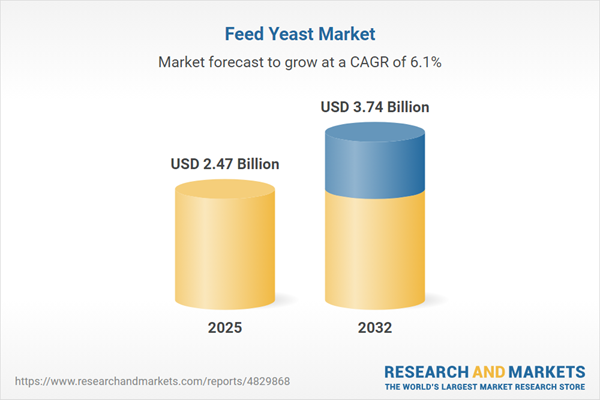Speak directly to the analyst to clarify any post sales queries you may have.
The feed yeast market is rapidly evolving as the industry shifts focus toward sustainable nutrition, regulatory compliance, and precision animal health. As pressure mounts for cleaner labels and efficient livestock production, innovative feed yeast solutions are reshaping the performance and value of commercial animal feeds.
Feed Yeast Market Snapshot
The Feed Yeast Market grew from USD 2.32 billion in 2024 to USD 2.47 billion in 2025 and is forecast to reach USD 3.74 billion by 2032, achieving a CAGR of 6.14%.
The sector is experiencing robust demand driven by regulatory shifts, a move toward antibiotic-free animal husbandry, and the pursuit of optimized feed efficiency. Recent production innovations, expanded R&D investment, and digital supply chain transformation underpin the market's healthy outlook. Global efforts to establish regionalized manufacturing and agile logistics continue to shape the competitive landscape and facilitate dependable growth.Scope & Segmentation
- Form: Dry, Liquid
- Type: Brewers Yeast, Dried Yeast, Live Yeast
- Distribution Channels: Offline, Online Sales (Company Website, E Commerce Platforms)
- End Use: Aquaculture, Poultry, Ruminants, Swine
- Application: Flavoring Agent, Probiotic Feed Additives, Protein Supplement
- Regions: Americas (North America: United States, Canada, Mexico; Latin America: Brazil, Argentina, Chile, Colombia, Peru), Europe, Middle East & Africa (Europe: United Kingdom, Germany, France, Russia, Italy, Spain, Netherlands, Sweden, Poland, Switzerland; Middle East: United Arab Emirates, Saudi Arabia, Qatar, Turkey, Israel; Africa: South Africa, Nigeria, Egypt, Kenya), Asia-Pacific (China, India, Japan, Australia, South Korea, Indonesia, Thailand, Malaysia, Singapore, Taiwan)
- Key Companies: Angel Yeast Co., Ltd., Lesaffre S.A., Alltech, Inc., Lallemand Inc., Diamond V, LLC, Chr. Hansen A/S, Novozymes A/S, Cargill, Incorporated, Koninklijke DSM N.V., Evonik Industries AG
Key Takeaways for Strategic Decision Makers
- Technological progress—including strain engineering, fermentation optimization, and bioprocess monitoring—is driving the quality and consistency of feed yeast products.
- Regulatory focus on sustainable livestock production and reduced antibiotic use is expanding the range of yeast-based additives in commercial diets.
- Collaborations between feed manufacturers and biotechnology providers accelerate adoption of precision nutrition solutions tailored to species and localized markets.
- Regional strategies are essential, as North America leads in antibiotic reduction policies while Asia-Pacific is scaling domestic supply and Europe pursues circular economy practices.
- Feed yeast increasingly serves multifunctional roles: supporting gut health, enhancing palatability, and supplying key amino acids for robust animal growth.
- Distribution channels are diversifying to meet the needs of both industrial-scale operations and specialty end-users through online and offline sales platforms.
Tariff Impact and Supply Chain Shifts in the Feed Yeast Market
United States tariff adjustments in 2025 have caused significant supply chain realignments, leading producers to prioritize local sourcing and invest in domestic fermentation facilities. These tariffs have prompted new alliances and an uptick in innovation, as companies search for cost-effective alternatives and flexible distribution. The move away from import-driven procurement is fostering a hybrid model, blending global expertise with regional production advantages to support long-term resilience.
Methodology & Data Sources
This report applies a dual-phase research methodology combining deep secondary analysis and direct stakeholder interviews. The secondary review encompasses scientific literature, trade publications, regulatory filings, and proprietary databases. Primary data is validated through discussions with executives, R&D staff, and procurement specialists across diverse market segments. Advanced data triangulation and sensitivity checks ensure robust and actionable findings.
Why This Report Matters
- Enables senior leaders to benchmark innovation and supply chain strategies against evolving regulatory and technology trends in the feed yeast market.
- Delivers actionable insights into new product development, regional growth opportunities, and risk mitigation approaches related to tariffs and sourcing disruptions.
- Supports competitive positioning by capturing segmentation patterns and profiling key industry players shaping future market direction.
Conclusion
The feed yeast market’s forward trajectory is defined by sustainability, innovation, and adaptive supply chains. Decision makers who align their strategies with these drivers will be well-positioned to leverage ongoing industry transformation and achieve resilient, profitable growth.
Additional Product Information:
- Purchase of this report includes 1 year online access with quarterly updates.
- This report can be updated on request. Please contact our Customer Experience team using the Ask a Question widget on our website.
Table of Contents
3. Executive Summary
4. Market Overview
7. Cumulative Impact of Artificial Intelligence 2025
Companies Mentioned
The companies profiled in this Feed Yeast market report include:- Angel Yeast Co., Ltd.
- Lesaffre S.A.
- Alltech, Inc.
- Lallemand Inc.
- Diamond V, LLC
- Chr. Hansen A/S
- Novozymes A/S
- Cargill, Incorporated
- Koninklijke DSM N.V.
- Evonik Industries AG
Table Information
| Report Attribute | Details |
|---|---|
| No. of Pages | 182 |
| Published | November 2025 |
| Forecast Period | 2025 - 2032 |
| Estimated Market Value ( USD | $ 2.47 Billion |
| Forecasted Market Value ( USD | $ 3.74 Billion |
| Compound Annual Growth Rate | 6.1% |
| Regions Covered | Global |
| No. of Companies Mentioned | 11 |









